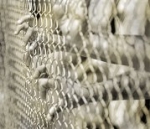09 January 2007
America's Prisons: Breeding Grounds for Muslim Converts
If I had to pick a single issue on which I would hope to see our counter-terrorism policy give more focus to during 2007, it would be to have real progress made in altering the mindsets, dynamics and structures in what are rapidly emerging as a major source of domestic Islamist terrorism, America's prisons and jails.
Some progress has already been made. Federal prison authorities and state authorities in larger jurisdictions have been fairly proactive in isolating suspected terrorists and known radical Islamists from the general inmate population. But more has to be done to stop prison authorities from continuing to condone a well-established propensity for Muslims inmates to self-segregate.
As controls in the US on the access of outside Imams to prisoners have tightened, the problem of Islamist radicalization in US prisons is one that involves much more self-radicalization. This seems to be especially the case amongst certain segments of the African-American inmate population that has converted to Islam while in prison.
It is notable that one of the more serious Jihadist terrorist plots, uncovered in Los Angeles by local law enforcement and the FBI, involved just such individuals. It is my strong belief that this is a specific area of counter-terrorism policy where relatively little effort on the part of federal, state and local authorities could have a disproportionately positive impact on our security. Much closer attention needs to be given to identifying, tracking and redirecting the types of inmates; those who are disproportionately drawn from minority communities, and who most closely parallel the angry and alienated Muslim immigrant youths who provide the foot soldiers for Islamist terrorists in Europe.
Such individuals and groups need to be treated in the same way we track other inmate factions, in particular prison gangs. For American prison authorities, this would be a much easier task than it is for their European counter-parts, as they can more easily surmount the language and cultural problems that be-devil such efforts in Europe. It is a matter of consciously making the effort to focus on the issue and to allocate the staff and resources necessary to address properly the threat such inmates, both individually and collectively, pose to the security of Americans, not while they are incarcerated, but after they regain their freedom.
However, I see no willingness yet to devote the kind of time, money and trained staff necessary to seriously tackle this extremely dangerous problem. Unfortunately, given the nature of our complex and decentralized prison system, such resources are only likely to materialize after a large-scale terrorist attack that involves just these types of self-radicalized, American Muslim converts. We continue in the face of this clearly emerging threat to be reactive, not proactive, in our approach to tackling the very real risks that arise as Islamic radicalization spreads amongst American-born minority inmates in prisons and jails. The reality is that attitudes to dealing with the problem are not evolving as quickly as the threat. It is a common difficulty, one that crops up continually in trying to get anything done across our entire counter-terrorist strategy.
![]()
FamilySecurityMatters.org Contributing Editor Ian Cuthbertson is an expert on European military affairs and trans-Atlantic security issues, the Director of the Counter-Terrorism Project at the World Policy Institute, and an adjunct professor at the New School
21:49 Posted in UNITED STATES | Permalink | Comments (0) | ![]() Facebook |
Facebook |




















The comments are closed.